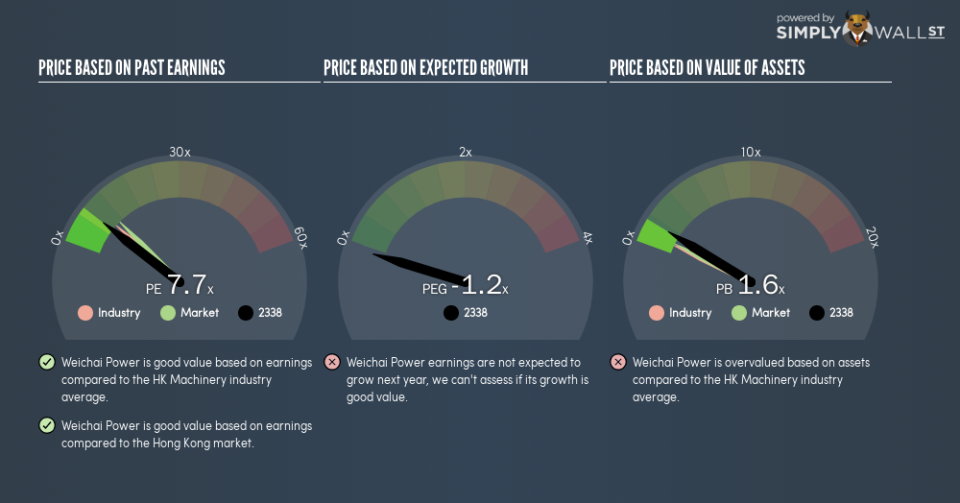Here’s How P/E Ratios Can Help Us Understand Weichai Power Co Ltd (HKG:2338)

This article is written for those who want to get better at using price to earnings ratios (P/E ratios). We’ll show how you can use Weichai Power Co Ltd’s (HKG:2338) P/E ratio to inform your assessment of the investment opportunity. Based on the last twelve months, Weichai Power’s P/E ratio is 7.71. In other words, at today’s prices, investors are paying HK$7.71 for every HK$1 in prior year profit.
View our latest analysis for Weichai Power
How Do You Calculate Weichai Power’s P/E Ratio?
The formula for price to earnings is:
Price to Earnings Ratio = Price per Share (in the reporting currency) ÷ Earnings per Share (EPS)
Or for Weichai Power:
P/E of 7.71 = CN¥7.69 (Note: this is the share price in the reporting currency, namely, CNY ) ÷ CN¥1.0 (Based on the trailing twelve months to September 2018.)
Is A High Price-to-Earnings Ratio Good?
A higher P/E ratio means that buyers have to pay a higher price for each HK$1 the company has earned over the last year. That isn’t necessarily good or bad, but a high P/E implies relatively high expectations of what a company can achieve in the future.
How Growth Rates Impact P/E Ratios
Earnings growth rates have a big influence on P/E ratios. That’s because companies that grow earnings per share quickly will rapidly increase the ‘E’ in the equation. That means even if the current P/E is high, it will reduce over time if the share price stays flat. So while a stock may look expensive based on past earnings, it could be cheap based on future earnings.
Notably, Weichai Power grew EPS by a whopping 40% in the last year. And earnings per share have improved by 16% annually, over the last five years. So we’d generally expect it to have a relatively high P/E ratio.
How Does Weichai Power’s P/E Ratio Compare To Its Peers?
We can get an indication of market expectations by looking at the P/E ratio. If you look at the image below, you can see Weichai Power has a lower P/E than the average (9.4) in the machinery industry classification.
This suggests that market participants think Weichai Power will underperform other companies in its industry. Since the market seems unimpressed with Weichai Power, it’s quite possible it could surprise on the upside. It is arguably worth checking if insiders are buying shares, because that might imply they believe the stock is undervalued.
A Limitation: P/E Ratios Ignore Debt and Cash In The Bank
Don’t forget that the P/E ratio considers market capitalization. In other words, it does not consider any debt or cash that the company may have on the balance sheet. Hypothetically, a company could reduce its future P/E ratio by spending its cash (or taking on debt) to achieve higher earnings.
Such spending might be good or bad, overall, but the key point here is that you need to look at debt to understand the P/E ratio in context.
How Does Weichai Power’s Debt Impact Its P/E Ratio?
The extra options and safety that comes with Weichai Power’s CN¥2.1b net cash position means that it deserves a higher P/E than it would if it had a lot of net debt.
The Bottom Line On Weichai Power’s P/E Ratio
Weichai Power trades on a P/E ratio of 7.7, which is below the HK market average of 10.8. The net cash position gives plenty of options to the business, and the recent improvement in EPS is good to see. The relatively low P/E ratio implies the market is pessimistic.
When the market is wrong about a stock, it gives savvy investors an opportunity. As value investor Benjamin Graham famously said, ‘In the short run, the market is a voting machine but in the long run, it is a weighing machine.’ So this free visual report on analyst forecasts could hold they key to an excellent investment decision.
You might be able to find a better buy than Weichai Power. If you want a selection of possible winners, check out this free list of interesting companies that trade on a P/E below 20 (but have proven they can grow earnings).
To help readers see past the short term volatility of the financial market, we aim to bring you a long-term focused research analysis purely driven by fundamental data. Note that our analysis does not factor in the latest price-sensitive company announcements.
The author is an independent contributor and at the time of publication had no position in the stocks mentioned. For errors that warrant correction please contact the editor at editorial-team@simplywallst.com.

 Yahoo Finance
Yahoo Finance 